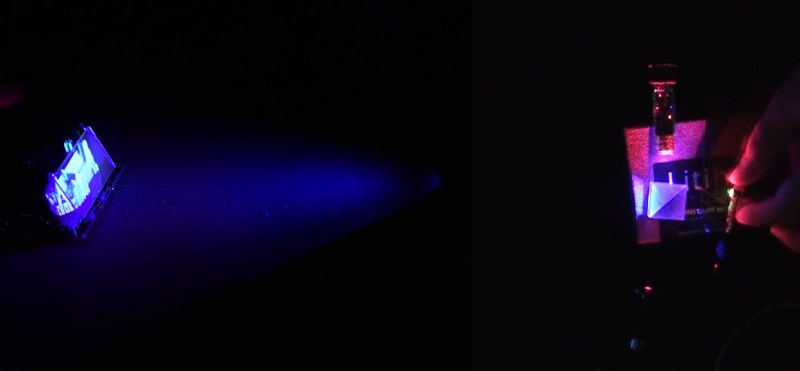Holograms are tricky to describe because science-fiction gives the name to any three-dimensional image. The science-fact versions are not as flashy, but they are still darn cool. Legitimate holograms are images stored on a photographic medium, and they retain a picture of the subject from certain angles. In other words, when [Justin Atkin] makes a hologram of a model building, (video, embedded below) you can see the east side of the belfry, but when you reorient, you see the west side, or the roof if you point down. Holography is different from stereoscopy, which shows you a 3D image using two cameras. With a stereoscopic image, you cannot tilt it and see a new part of the subject, so there is a niche for each method.
There are a couple of different methods for making a hologram at home. First, you probably want a DIY hologram kit since it will come with the exposure plate and a known-good light source. Far be it for us to tell you you can’t buy plates and a laser pointer to take the path less traveled. Next, you need something that will not move, so we’re afraid you cannot immortalize your rambunctious kitty. The last necessity is a stable platform since you will perform a long-exposure shot, and even breathing on the setup can ruin the image. Different colors come from the coherent light source, so getting the “Rainbow Holograms” advertised in the video is a matter of mixing lights. Since you can buy red, green, and blue laser pointers for a pittance, you can do color remixes to your content.
Another type of hologram appears on things like trading cards as those wildly off-color (chromatic, not distasteful) images of super-heroes or abstract shapes. They’re a different variety, which can be printed en-masse, unlike the one-off [Justin] shows us how to make.
If you’re yearning for volumetric displays, we are happy to point you to this beauty capable of showing a jaw-dropping 3D model or this full-color blocky duck.
















Having nearly got through a mass production of some holograms, 2 years in the making, I’m not so sure the hologram Justin mastered couldn’t be taken to high volume manufacture.
It depends if it is stored on a plane (possible) or in a volume (impossible) of the light sensitive gelatin.
Right, I didn’t look into the video or the chemistry used but usually silver photoemulsions do leave a topography (such that taking impressions would be possible).
Great crash course in hologram making.
This video brought to you by Litiholo.
You don’t even know it’s a paid ad until ten minutes in.
He also doesn’t adequately explain that all of his examples used >$200 in free ‘upgrades’.
So, when do we get holograms projected into open air that we can wave our hands through?
likely in 10 or 15 years. maybe 20. we can wave through projectors
this is the best hologram explanation . could this be done with cell phones and gelatin?